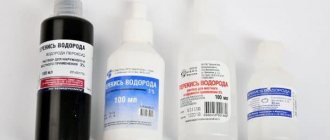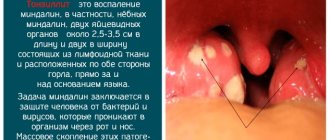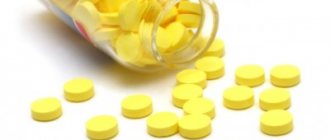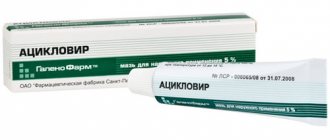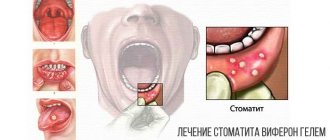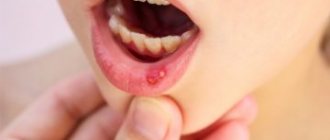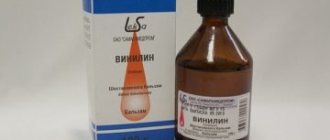Good day, dear visitors. You probably know that stomatitis is one of the most common diseases in the practice of a dentist. This problem concerns not only children who put toys and banal garbage into their mouths, but also adult patients. Therefore, we decided to discuss such an interesting topic as oxolinic ointment for stomatitis.
Oxolinic ointment for stomatitis
Developed back in Soviet times, this simple ointment is still produced by the pharmaceutical industry in post-Soviet countries and has proven that it is in no way inferior to more modern analogues. It is also produced under the names Oxonaphthylin and Tetraxolin. At the same time, oxolin is not written about outside the CIS, and drugs based on it are considered a curiosity.
Oxolinic ointment is one of the few that uses only one active ingredient. In modern pharmacology, mono-based ointments are rarely used.
Oxolinic ointment
Features of the use of oxolinic ointment for stomatitis
The use of oxolinic ointment for stomatitis is effective for the reason that oxolinic is able to destroy and slow down the reproduction of many parasites and viruses, including such a common one as herpes. As you know, the herpetic form of stomatitis is one of the most common in the world, sharing the palm with candidiasis.
Attention! Oxolin is not a universal remedy for all forms of the disease. It is not used for stomatitis caused by candida fungi. Another ointment combats them - nystatin.
This remedy will not help with candidal stomatitis.
- Oxolinic ointment not only reduces ulcers, but also reduces their pain.
- The ointment can be used not only for treatment, but also as an effective and inexpensive prophylactic.
- There is nothing harmful in the composition. In addition to oxoline, it contains petroleum jelly, paraffin, and citric acid.
- Do not confuse 3% and 0.25% ointment. The first is intended for external use.
Herpetic stomatitis
Acute herpetic stomatitis is a common problem. When transmitted from person to person, the herpes virus is never completely destroyed, integrating into the DNA of the carrier. It is not yet possible to completely destroy it.
Now there are many products on the market that promise to help you get rid of the virus once and for all. This is nothing more than a publicity stunt.
Herpetic stomatitis is characterized by painful rashes not only on the mucous membrane of the mouth
The active ingredient – oxolin – helps strengthen cell membranes. This makes it more difficult for the virus to penetrate the membrane. This leads to localization of the infection. Now the immune system is quite capable of coping on its own.
Video - Does oxolinic ointment help fight viruses?
Types of stomatitis
The disease is characterized by ulceration of the oral mucosa; however, stomatitis is caused by different viruses. There are several types of disease:
- herpes;
- candida;
- aphthous;
- allergic.
The most common type of stomatitis is considered to be aphthous: it occurs due to poor-quality sanitation of the oral cavity or injury to the mucous membrane. Candidal stomatitis most often affects the mucous membranes of children, while herpes stomatitis is of viral origin.
If the disease is fungal in nature, antifungal drugs should be used; for aphthous stomatitis, antibacterial agents are used; for viral stomatitis, oxolin is used. If the nature of stomatitis is allergic in nature, ointments/gels with antifungal/antiviral agents will not help!
It is important to understand: each type of stomatitis is treated according to a specific scheme. Therefore, independent use of medications is unacceptable. Oxolinic ointment helps only with the viral nature of ailments, in particular, ulceration of the oral mucosa.
The cause of stomatitis can be an incorrect bite, bad habits in a child, or a lack of minerals in the body. Therefore, it makes no sense to use oxolin in this case. Before starting treatment, consult your dentist.
Oral preparation
Oxolinic ointment for stomatitis in adults is used as follows. Before using the ointment, it is necessary to treat the mucous membrane.
- Using a cotton swab soaked in sea buckthorn, rosehip oil or an oil solution of vitamin A, treat the surface affected by stomatitis. It is necessary to remove dried crusts.
- Next, you need to rinse your mouth. A decoction of calendula, chamomile or nettle is suitable for this purpose. If you have chamomile tincture on hand, that can also be used.
- To eliminate discomfort and pain, you can use various antiseptic solutions.
Nettle decoction
Some people believe that it is enough to anoint the sores a couple of times and everything will go away. This is a common misconception caused by advertising of various medications. In real medicine there is no such thing as on TV. In order for the active substance to produce the desired effect, the procedure is repeated up to 4 times a day. The duration of treatment ranges from 5 days to a week.
Another important point is how to smear. Most people only apply the ointment to the sores themselves. This is the wrong approach. In this case, the viral infection may spread to other nearby areas. In order for the effect to be maximum, it is necessary to treat the mucous membrane completely. After the ointment is applied, do not eat or drink for an hour. Only in this case is it possible to obtain a therapeutic effect.
The ointment must be applied correctly
Advantages and disadvantages
The positive qualities of the drug include:
- Availability. Low cost, unlike other medications. Constant availability of medicines in pharmacies.
- Productivity. Using the ointment allows you to cope with most diseases for which it is recommended. In addition, it is an excellent preventive measure.
- Harmlessness. The drug is absolutely safe for use. It can be used to treat any age group of people. It does not accumulate in the body and is quickly eliminated from it.
- Painless. Applying the ointment does not cause pain; in some cases, a slight tingling or burning sensation is possible. After removing papillomas with the help of ointment, there are no traces left, there are no scars or scars.
The disadvantages include:
- Vaseline is the basis of the drug. The ointment does not adhere well to mucous membranes and is often swallowed by a child; for this reason, it is necessary to use it with caution when treating young children, follow reasonable dosages and take advantage of additional recommendations.
- Duration when used. A long course of treatment may be required compared to surgery, which provides immediate results.
- Low efficiency. In advanced cases of the disease, the use of oxolinic ointment alone may not be enough, and the use of additional drugs for complex therapy will be required.
The use of oxolinic ointment in the treatment of stomatitis in a child
The body of children is always more susceptible to infections than that of adults. This is due to the fact that the immune system is not yet developed and powerful enough to fight them.
Preliminary preparation of the oral cavity of children is no different from the process described above in adult patients. But there is one nuance here. It is difficult to get a baby to rinse his mouth with some strange and not particularly tasty liquid. Oksolin is used from the age of two inclusive. Can you imagine two-year-old children briskly running to the sink with a cup of broth? So the doctors have no idea. If oxolinic ointment is used for stomatitis in a child, rinsing can be replaced by wiping the affected areas with a swab soaked in the above compositions.
Oxolinic ointment can be used for children
What is good about oxolin? Children do not always tolerate strong antibiotics and drugs with antibacterial effects well. In such cases, this ointment becomes a simple and safe alternative.
Another plus is the price. Go to any pharmacy and see how much medications for herpetic stomatitis cost. There are no particles of gold or blessings from above in the composition. These are ordinary pharmaceutical products of domestic and foreign production. There is nothing rare, expensive or complicated about them. Moreover, they cost so much that for this money the director of the factory must bring a tube to your door. With oxolin everything is much simpler.
The price of oxolinic ointment is low
In addition, this substance has long been tested, tested, and does not raise any complaints regarding its effectiveness and safety for the patient. The same cannot be said about newfangled compounds, the use of which in domestic medicine simply does not exist. Risking the health of children is not the best option when treating ordinary stomatitis.
The important thing is that this is not a symptomatic drug, but a therapeutic one. It not only eliminates external manifestations, but also fights directly with the herpes virus itself. In order to increase effectiveness, it is recommended to simultaneously use drugs that increase immunity in the oral cavity.
Oxolinic ointment 0.25%
As mentioned above, oxolinic ointment is allowed to be used in the treatment of stomatitis in children starting from two years of age. The point is not that it will harm the baby. There simply have not been any studies that would confirm the safety of using oxolin preparations in infants and newborns.
The main disadvantage of the ointment is its liquid consistency. Children quickly lick and swallow it. Often the active ingredients do not have time to produce the desired effect.
Read the instructions carefully
How to replace the drug
What ointments/gels are used for stomatitis? The pharmaceutical industry offers the following drugs:
- acyclovir;
- nystatin;
- methyluracil;
- Cholisal;
- solcoseryl;
- Metrogil denta.
Acyclovir suppresses the activity of the herpes virus and has a similar effect to oxolinic ointment. Nystatin is used for the fungal form of the disease - candidiasis. Methyluracil (and Solcoseryl) is used for the bacterial form of the disease (aphthous type).
Cholisal is a universal gel for all forms of illness. This drug can also be used in infants up to one year old. The disadvantage of the drug is its high price. Metrogyl Denta contains an antibiotic, so self-prescription of the drug is unacceptable. This product is approved for use by children over six years of age.
Precautions and contraindications in the treatment of oxolinic ointment for stomatitis
There is no information about the dangers of oxolin during pregnancy and during feeding. However, you should consult your doctor about this. He will give recommendations for use. Since no studies have been conducted, it is difficult to say how safe the penetration of oxolin into the mother’s body will be for the fetus.
Individual people may have individual reactions to the components of the ointment (oxolin and additives). If an allergy occurs, you must stop using the ointment and replace it with other products that have a similar effect.
Sometimes ointment can lead to allergic reactions
The drug is non-toxic. When applying the ointment to the mucous membranes, no more than a quarter of the volume of the substance is absorbed. At the moment, there is no information about cases involving an overdose of the active substance. Also keep in mind that the ointment dries out the mucous membranes a little; some babies experience irritation and a burning sensation at the sites of application. If such sensations occur, it is recommended to rinse your mouth with chamomile decoction.
Do not self-medicate, and especially treat a child, without the advice of your doctor.
Oxolinic ointment for stomatitis - photo
Release form: tube with a plastic cap. Volume – 10 grams. This is enough for several days of regular use.
Look carefully at the release date. The shelf life of oxolinic ointment is two years. Do not use expired medication. In order for oxolin to retain its properties, it is recommended to store it at a temperature no higher than +10 degrees. When heated, the ointment becomes too liquid and does not adhere to the mucous membranes.
imaOxolinge description
As you can see, this cheap and simple ointment from the pharmacy has excellent effectiveness at a cheap price. Since its invention in 1970, it has shown good results in the fight against viral infections.
5 best analogues of oxolinic ointment in the fight against stomatitis:
| Name | Description | Price |
| Kamistad gel | It is produced in the form of a gel and ointment. This product must be applied to the affected area of the mucous membrane in a small layer, rubbing in with light movements. Apply 3 times a day | from 256 rubles |
| Holisal | Used when the oral mucosa is affected by a traumatic or bacterial disease of this type. This effective product is very popular | from 191 rubles |
| Metrogil Denta | It has a pronounced anti-inflammatory and antimicrobial effect. Due to the low concentration of the antibiotic, the product is harmless to the body | from 227 rubles |
| Solcoseryl | Dental adhesive ointment with wound healing, antihypoxic and regenerating effects | from 400 rubles |
| Acyclovir 5% 5g | A product that helps destroy the internal structure of viruses by penetrating their DNA chain | from 22 rubles |
This concludes our story. We hope that the article was useful to you. We are waiting for your comments. By subscribing to the newsletter, you will receive the most interesting and latest news from our website!
Contraindications and side effects
Ointment for stomatitis can cause discomfort in the form of a burning sensation. This condition should go away after some time. If the pain persists and the swelling increases, it means that one of the components of the medicine has caused an allergic reaction. In this case, treatment with oxolinic ointment should be stopped.
The drug should be used with caution during pregnancy and breastfeeding. Oxolinic ointment is not recommended for children under two years of age.
Oxolinic ointment is an effective remedy for the treatment of stomatitis. But before using the drug, it is better to consult a specialist.
After watching the video, you will learn about Oxolinic ointment:
Release form and indications for use
The drug is released in the form of an ointment. It is transparent in color and has medium consistency. Before determining the indications for use of the ointment, it is worth understanding the causative agents of stomatitis:
- viruses (most often herpes),
- poor oral hygiene and various bacteria leading to the development of the disease,
- fungi (most often they affect the body of young children),
- specific allergy.
Aphthous stomatitis is the most common form of the disease. It occurs due to poor hygiene or as a result of minor injuries or cracks into which infection seeps. Taking into account the cause that influenced the development of the inflammatory process, a drug is prescribed that can act on the form of bacteria that led to damage to the mucous membrane.
Attention! If the cause of the disease lies in allergies, then Oxolinic ointment will not have the proper therapeutic effect. In this case, it is effective to prescribe antiallergic drugs.


